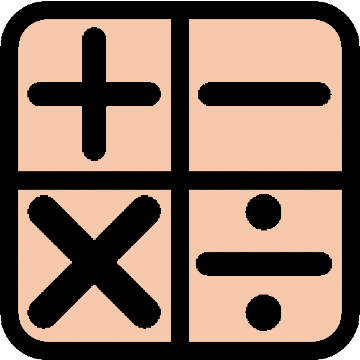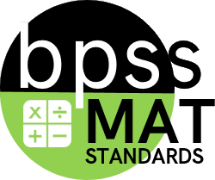MAT-07.NO.O.02

|
7th Grade (MAT) Targeted Standard
(NO) Number and Operations
(O) Operations
Learners will expand their computational fluency to create connections and solve problems within and across concepts.
|
MAT-07.NO.O.02 Add, subtract, multiply, and divide non-negative fractions in multi-step problems, including authentic problems.*
 Proficiency Scale Proficiency Scale
Progressions
Addition and Subtraction
- MAT-01.NO.NBT.03 Add within 100 using a two-digit number and a one-digit number. Use concrete models, drawings, and strategies that reflect an understanding of place value.
- MAT-02.NO.NBT.03 Add within 100 using place value strategies and/or the relationship between addition and subtraction.
- MAT-01.NO.NBT.04 Subtract multiples of 10 within 100 using concrete models, drawings, and strategies that reflect an understanding of place value.
- MAT-01.NO.NBT.05 Mentally add or subtract 10 to or from a given two-digit number and explain the reasoning used.
- MAT-02.NO.NBT.04 Subtract within 100 using place value strategies and/or the relationship between addition and subtraction.
- MAT-02.NO.NBT.05 Mentally add or subtract 10 or 100 to or from a given number between 100 and 900.
- MAT-03.NO.NBT.03 Add and subtract within 1000 using place value strategies, algorithms, and/or the relationship between addition and subtraction.
- MAT-04.NO.NBT.04 Add and subtract multi-digit whole numbers to the one million place using strategies flexibly, including the algorithm.
- MAT-05.NO.NBT.05 Use concrete models, drawings, place value strategies, properties of operations, and/or relationships to add, subtract, and multiply decimals to hundredths.
- MAT-07.NO.O.01 Add, subtract, multiply, and divide integers using visual models and properties of operations in multi-step authentic and mathematical problems, including authentic problems.
- MAT-07.NO.O.02 Add, subtract, multiply, and divide non-negative fractions in multi-step problems, including authentic problems.
- MAT-07.NO.O.03 Add, subtract, multiply, and divide non-negative decimals to the hundredth place in multi-step problems using strategies or procedures, including authentic problems.
- MAT-08.NO.O.02 Add, subtract, multiply, and divide rational numbers using strategies or procedures.
- MAT-09.NO.02 Perform basic operations on simple radical expressions to write a simplified equivalent expression.
- MAT-09.AR.11 Add, subtract, and multiply polynomials.
- MAT-12.NO.03 Demonstrate that the sum or product of two rational numbers is rational; that the sum of a rational number and an irrational number is irrational, and that the product of a nonzero rational number and an irrational number is irrational.
- MAT-12.AR.13 Add, subtract, and multiply polynomials beyond quadratics. Understand that polynomials form a system comparable to the integers, namely, they are closed under the operations of addition, subtraction, and multiplication.
- MAT-12.NO.11 Represent addition, subtraction, multiplication, conjugation, powers, and roots of complex numbers geometrically on the complex and/or polar plane; use properties of this representation for computation.
- MAT-12.NO.17 Add and subtract vectors. Represent vector subtraction graphically by connecting the tips of the appropriate order and using the components to perform vector subtraction.
- MAT-12.NO.19 Represent data in a matrix. Perform operations (i.e., addition, subtraction, multiplication) on matrices of appropriate dimensions to solve problems and in context. Know that matrix multiplication is not commutative.
Multiplication and Division
- MAT-03.NO.NBT.04 Multiply one-digit whole numbers by multiples of 10 within 100.
- MAT-04.NO.NBT.05 Multiply a whole number up to four digits by a one-digit whole number and multiply two two digit numbers. Show and justify the calculation using equations, rectangular arrays, and models.
- MAT-05.NO.NBT.04 Multiply multi-digit whole numbers using strategies flexibly, including the algorithm.
- MAT-05.NO.NBT.07 Explain patterns in the number of zeros of the product when multiplying a number by powers of 10. Explain patterns in the placement of the decimal point when a decimal is multiplied or divided by a power of 10. Use whole-number exponents to denote powers of 10.
- MAT-04.NO.NBT.06 Find whole-number quotients and remainders with up to four-digit dividends and one-digit divisors using place value strategies. Show and justify the calculation by using equations, rectangular arrays, and models.
- MAT-05.NO.NBT.05 Use concrete models, drawings, place value strategies, properties of operations, and/or relationships to add, subtract, and multiply decimals to hundredths.
- MAT-05.NO.NBT.06 Find whole-number quotients and remainders with up to four-digit dividends and two-digit divisors using place value strategies. Show and justify the calculation using equations, rectangular arrays, and/or area models.
- MAT-06.NO.O.01 Divide multi-digit whole numbers up to four-digit dividends and two-digit divisors using strategies or procedures.
- MAT-07.NO.O.01 Add, subtract, multiply, and divide integers and positive rational numbers using visual models and properties of operations in multi-step problems, including authentic problems.
- MAT-07.NO.O.02 Add, subtract, multiply, and divide non-negative fractions in multi-step problems, including authentic problems.
- MAT-07.NO.O.03 Add, subtract, multiply, and divide non-negative decimals to the hundredth place in multi-step problems using strategies or procedures, including authentic problems.
- MAT-08.NO.O.01 Evaluate mentally the square roots of perfect squares up to 225 and cube roots of perfect cubes up to 1000.
- MAT-08.NO.O.02 Add, subtract, multiply, and divide rational numbers using strategies or procedures.
- MAT-09.NO.02 Perform basic operations on radicals and simplify radicals to write equivalent expressions.
- MAT-09.AR.11 Add, subtract, and multiply polynomials.
- MAT-12.NO.03 Demonstrate that the sum or product of two rational numbers is rational, that the sum of a rational number and an irrational number is irrational, and that the product of a nonzero rational number and an irrational number is irrational.
- MAT-12.AR.13 Add, subtract, and multiply polynomials beyond quadratics. Understand that polynomials form a system comparable to the integers, namely, they are closed under the operations of addition, subtraction, and multiplication.
- MAT-12.NO.11 Represent addition, subtraction, multiplication, conjugation, powers, and roots of complex numbers geometrically on the complex and/or polar plane; use properties of this representation for computation.
- MAT-12.NO.19 Represent data in a matrix. Perform operations (i.e., addition, subtraction, multiplication) on matrices of appropriate dimensions to solve problems and in context. Know that matrix multiplication is not commutative.
Adding and Subtracting Fractions
- MAT-04.NO.NF.06 Solve authentic word problems by adding and subtracting fractions and mixed numbers with like denominators (proper and improper fractions limited to denominators of 2, 3, 4, 5, 6, 8, 10, 12, and 100).
- MAT-05.NO.NF.03 Solve authentic word problems by adding and subtracting fractions and mixed numbers with unlike denominators using a visual fraction model and/or equation.
- MAT-06.NO.O.02 Add and subtract fractions and decimals up to the hundredth place, including in authentic problems.
- MAT-07.NO.O.02 Add, subtract, multiply, and divide non-negative fractions in multi-step problems, including authentic problems.
- MAT-08.NO.O.02 Add, subtract, multiply, and divide rational numbers using strategies or procedures.
- MAT-12.NO.04 Demonstrate that the sum or product of two rational numbers is rational, that the sum of a rational number and an irrational number is irrational, and that the product of a nonzero rational number and an irrational number is irrational.
- MAT-12.AR.05 Add, subtract, multiply, and divide rational expressions. Understand that rational expressions form a system analogous to rational numbers, closed under addition, subtraction, multiplication, and division by a nonzero rational expression.
- MAT-12.NO.06 Know there is a complex number i such that i² = -1, and every complex number has the form a + bi with a and b real. Understand the hierarchal relationships among subsets of the complex number system.
Multiplying and Dividing Fractions
- MAT-04.NO.NF.07 Solve problems by multiplying fractions and whole numbers using visual fraction models (proper and improper fractions limited to denominators of 2, 3, 4, 5, 6, 8, 10, 12, and 100).
- MAT-05.NO.NF.02 Explain why multiplying a given number by a fraction greater than one results in a product greater than the given number and explain why multiplying a given number by a fraction less than one results in a product smaller than the given number.
- MAT-05.NO.NF.04 Solve authentic word problems by multiplying fractions and mixed numbers using visual fraction models and equations.
- MAT-06.NO.O.03 Apply multiplication and division of fractions and decimals to solve and interpret problems using visual models, including authentic problems.
- MAT-07.NO.O.02 Add, subtract, multiply, and divide non-negative fractions in multi-step problems, including authentic problems.
- MAT-08.NO.O.02 Add, subtract, multiply, and divide rational numbers using strategies or procedures.
- MAT-09.NO.02 Perform basic operations of simple radical expressions to write a simplified equivalent expression.
- MAT-12.NO.03 Demonstrate that the sum or product of two rational numbers is rational, that the sum of a rational number and an irrational number is irrational, and that the product of a nonzero rational number and an irrational number is irrational.
- MAT-12.NO.02 Perform basic operations on advanced radicals and simplify radicals to write equivalent expressions.
- MAT-12.AR.5 Add, subtract, multiply, and divide rational expressions. Understand that rational expressions form a system analogous to rational numbers, closed under addition, subtraction, multiplication, and division by a nonzero rational expression.
- MAT-12.NO.06 Know there is a complex number i such that i² = -1, and every complex number has the form a + bi with a and b real. Understand the hierarchal relationships among subsets of the complex number system.
|


